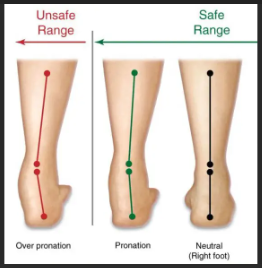If a child does not wear correct shoes with arch support, several problems can develop, particularly related to their foot health and overall well-being. Here are some potential issues that may arise:
1.) Flat Feet: One of the most common problems associated with improper arch support is flat feet. Flat feet occur when the arch of the foot collapses, causing the entire sole to come into contact with the ground. This can lead to pain, fatigue, and difficulty with activities that require standing or walking for extended periods.
2.) Overpronation: Overpronation refers to an excessive inward rolling of the foot during walking or running. It is often seen in individuals with low or collapsed arches. Without proper arch support, overpronation can cause strain on the feet, ankles, knees, and hips. This leads to overuse injuries such as plantar fasciitis, shin splints, or IT band syndrome.
3.) Poor Posture and Alignment: The feet play a crucial role in maintaining overall body posture and alignment. Without proper arch support shoes, a child may develop poor posture habits. You know them - slouching or leaning forward, to compensate for imbalances in their feet. This can contribute to musculoskeletal issues in the spine, hips, and shoulders over time.
4.) Foot Fatigue and Discomfort: Lack of arch support can result in increased foot fatigue and discomfort, especially during activities that involve prolonged standing, walking, or running. This can affect a child's participation in sports, physical education classes, and recreational activities, impacting their overall enjoyment and performance.
5.) Risk of Injuries: Insufficient arch support can increase the risk of various foot and lower limb injuries, including stress fractures, Achilles tendonitis, and ankle sprains. The lack of proper shock absorption and stability can put additional stress on vulnerable areas of the foot and leg. This makes injuries more likely, particularly during high-impact or repetitive activities.
6.) Muscle Strain and Imbalance: Shoes without an adequate arch support can cause a muscle strain and imbalance in the feet and lower legs. Certain muscles may become overworked or underutilized. This contributes to issues such as calf tightness, weak arch muscles, and reduced overall foot strength. This can further exacerbate problems like flat feet or overpronation.
7.) Developmental Concerns: In growing children, improper footwear with insufficient arch support can interfere with normal foot development. It can alter the natural arch formation process and potentially lead to long-term structural issues if not addressed early.
8.) Reduced Athletic Performance: For children involved in sports and physical activities, wearing shoes without proper arch support can hinder their athletic performance. It may affect their speed, agility, balance, and overall movement efficiency, limiting their potential and increasing the likelihood of fatigue-related issues during training or competitions.
To mitigate these problems, it's crucial for parents and caregivers to ensure that children wear properly fitted shoes with adequate arch support, especially during periods of rapid growth and development. Consultation with a podiatrist or footwear specialist can help determine the appropriate shoe type and support needed based on the child's foot structure, activity level, and any existing foot-related concerns. Encouraging good foot care habits early on can promote optimal foot health and overall physical well-being in children.
In our eshop www.feelgoodshoes.ae you can find shoes with a mild arch support and off-the-rack orthopedic sandals with a high arch support. Starting from EU 20, the first size a first walker needs.
Overpronation - off-the-rack orthopedic sandals can help your child avoid this problem.

You can read more on overpronation in this article: Disease/Condition: Overpronation: What It Is, Causes & Treatment (clevelandclinic.org)
